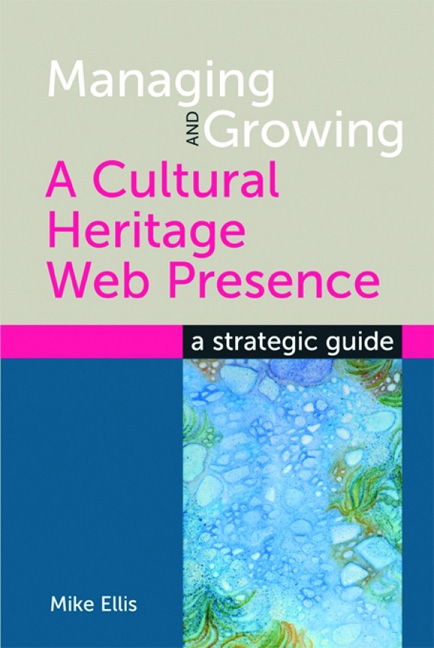Book contents
- Frontmatter
- Dedication
- Contents
- Acknowledgements
- Glossary
- Introduction
- 1 Evaluating what you have now
- 2 Building a strategic approach
- 3 Content
- 4 Marketing
- 5 Policies and guidelines
- 6 Traffic and metrics
- 7 The social web (Web 2.0)
- 8 The website project process
- 9 Away from the browser
- 10 Bringing it all together
- Bibliography
- Index
- Frontmatter
- Dedication
- Contents
- Acknowledgements
- Glossary
- Introduction
- 1 Evaluating what you have now
- 2 Building a strategic approach
- 3 Content
- 4 Marketing
- 5 Policies and guidelines
- 6 Traffic and metrics
- 7 The social web (Web 2.0)
- 8 The website project process
- 9 Away from the browser
- 10 Bringing it all together
- Bibliography
- Index
Summary
Introduction
One of the increasingly important things to take into account when developing a strategic approach for your web presence is – ultimately – to determine, measure and communicate how effective it is. ‘Effectiveness' is a highly subjective measure. It is subjective not only to a particular context but also to a particular user and occasion of use. For a user who is looking for opening times and nothing else, an ‘effective' web presence is one which provides this information in as few clicks as possible. For a researcher who wants to collect as much information about a specific topic as possible, effectiveness is about the depth of content available to them, the completeness of an archive. For a schoolteacher putting together a lesson plan, effectiveness might be something to do with the quality of downloadable resources that are available to them.
The way in which you understand your audience is therefore crucial when it comes to building user experiences which are relevant and effective for them.
Using metrics effectively is a cyclical process: it is about improvementof the service that you offer based on an iterative feedback loop in which you measure, compare and refine. This improvement only comes about if you understand what you are measuring and why.
‘We report our web metrics not only to our web team but to other places internally. We have a cross-departmental group, a Library Board, and will shortly be delivering these metrics to the public through a “zeitgeist” report.'
Paul Bevan,
National Library of Wales, UKIn this chapter we'll look at web metrics generally and examine how you can get these, how you can interpret them, and how you can disseminate them. You should bear in mind, however, that these general approaches mostly just scrape the surface and only provide a ‘top-down' idea of how your site is performing. These figures are probably the only ones your stakeholders will be asking for or interested in, but you should always bear in mind that true insight requires an under - standing of your audience, and of your particular context and ‘success', whatever that may be.
- Type
- Chapter
- Information
- Managing and Growing a Cultural Heritage Web PresenceA strategic guide, pp. 99 - 116Publisher: FacetPrint publication year: 2011



